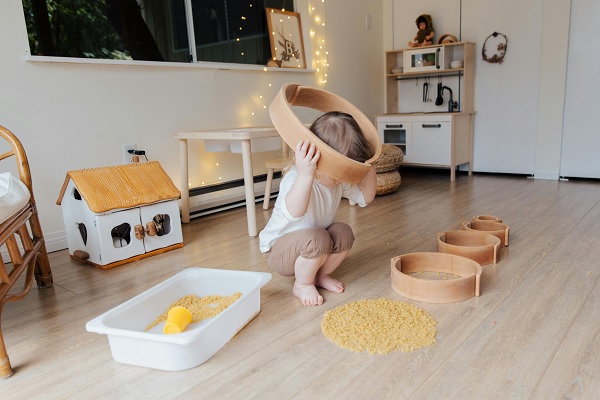Even if the room is small or you are organizing space for two siblings, it is quite possible to select furniture and accessories and plan the interior in a way that promotes children’s development while making the room comfortable, ergonomic, and functional.
Montessori Interior Organization Principles
Maria Montessori was one of the first to notice the connection between a child’s developmental success and the environment they grow up in. She emphasized that children have an “absorbing mind,” learning from everything around them, literally absorbing information. Therefore, she proposed universal rules for organizing space that help create an interior that promotes cognitive, physical, and emotional development.
- The environment should be adapted to the child’s abilities and needs. This means that the bed, bookshelf, wardrobe—everything should be at the child’s height, allowing even preschoolers to use their room without parental or caregiver assistance.
- The fewer distractions and unnecessary elements in the space, the easier it is to navigate. Therefore, the room shouldn’t be overloaded with a lot of furniture, toys, and decor. Minimalism and order are the best options.
- Every item should have its place. Books on shelves, clothes on hangers, in wardrobes, on closet shelves, and toys in baskets and boxes. This way, both you and the child will always know where everything is and how to find it.
- Prefer multifunctional furniture, as Montessori nursery furniture allows for various uses. For example, sports beds serve as both sleeping places and spaces for training and play, and children’s climbing frames serve for entertainment and development.
With these rules, you can create coziness and ensure proper functionality even in a small room.
How to Make the Space Comfortable in Limited Conditions?
Let’s move from theory to practice and make the interior contain everything necessary and nothing superfluous. First of all, the child needs to have a place to play, learn, rest, exercise, and store things. Divide the space into appropriate functional zones.
Next, let’s choose Montessori nursery furniture that can perform different functions, which is critically important in limited space. For example, to save room space, you can opt for a semi-loft bed: the sleeping area is on top, while underneath you can place a desk, or wardrobe, or organize a play area. If you are creating an interior for two kids, you can choose a regular bunk bed to make the most of the vertical space.
What Furniture Helps a Child Develop Without Overloading the Space?
For active early development, choose a set with a climbing arch, ramp, and climbing triangle. These elements take up minimal space and are designed to help the child develop muscles, motor skills, and coordination, and train the vestibular apparatus. Exercises on such equipment also promote cognitive development. Each piece of such a set can be used separately or combined with other Montessori equipment. Additionally, they can be folded and put away when not in use.
Another great option is monkey beds. These are sports beds with various climbing frames, ladders, and trainers. Such a bed is also a full-fledged sports corner. It greatly helps save space and makes the room uncluttered while remaining functional and attractive to the child.
Shelves on walls, bedside organizers, and under-bed storage are secret places to store small things. This makes it easier to find a place for each item and keep order.
What Else?
As an experiment, try choosing furniture and planning the interior of the nursery by actively involving your child in the process. This will not only help create a comfortable and safe space but also promote the development of independence, responsibility, and confidence in your child. People with these qualities grow up to be successful and happy.
